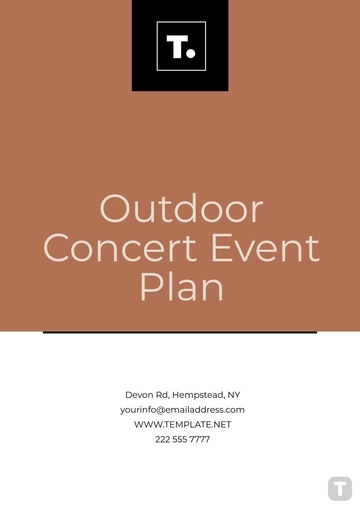Free Outdoor Concert Event Plan

I. Event Overview
This section provides an introduction to the outdoor concert, outlining its purpose, goals, and overall concept.
1.1 Purpose and Goals
The primary objective of this outdoor concert is to deliver a vibrant, memorable entertainment experience while spotlighting local talent. The event aims to foster community engagement, support regional artists, and create a family-friendly atmosphere where all attendees feel welcome. Key goals include:
Promoting local musicians and performers
Attracting up to 5,000 attendees
Creating a community-centric event that appeals to various age groups
1.2 Event Concept
The outdoor concert will feature a diverse lineup of musical performances, complemented by a variety of food and beverage vendors, interactive activities for families and children, and spaces for local businesses to engage with attendees. The event is designed to entertain and inspire, offering a lively, inclusive environment that highlights the cultural vibrancy of the local community.
II. Planning and Logistics
This section covers the essential logistical details required to successfully plan and execute the event.
2.1 Venue Selection
The venue must be an easily accessible outdoor location that can comfortably accommodate the expected 5,000 attendees while providing key amenities.
Key Criteria:
Capacity: 5,000 Attendees
Accessibility: Wheelchair-accessible paths, nearby parking facilities, and designated drop-off zones
Facilities: Adequate restrooms, power outlets for vendors and stage equipment, shaded areas, and seating zones
2.2 Permits and Regulations
Securing the necessary permits and complying with local regulations is essential for a smooth and lawful event execution. The following permits should be prioritized:
Noise permits to allow for amplified sound throughout the event
Food and beverage permits for vendors
Safety permits ensuring fire, crowd control, and general safety standards are met
Security clearances as per local authority requirements
2.3 Equipment and Rentals
A detailed list of equipment required for the event, along with suppliers and estimated costs, is provided below:
Equipment | Supplier | Cost |
|---|---|---|
Stage and sound system | Local Sound Co. | $5,000 |
Lighting solutions | BrightLights Inc. | $2,500 |
Portable restrooms | Clean & Easy Rentals | $1,200 |
Tents and canopies | Shade Solutions LLC | $1,800 |
Tables and seating | Event Essentials | $1,000 |
III. Marketing and Promotion
This section outlines the marketing strategies to promote the event and attract the desired audience.
3.1 Target Audience
The event will cater to a diverse audience, with a focus on:
Local community members seeking a fun, social experience
Music enthusiasts who appreciate live performances
Families looking for child-friendly activities and entertainment
Young adults who enjoy vibrant, festival-like atmospheres
3.2 Promotion Channels
A multi-channel marketing approach will be used to ensure broad outreach and maximum attendance. The primary promotion channels include:
Social media campaigns (Facebook, Instagram, Twitter) with targeted ads to local demographics
Email newsletters to previous event attendees and local subscribers
Local radio and television advertisements to raise awareness in the region
Collaborations with local businesses to offer cross-promotions and sponsorship opportunities
IV. Safety and Security
Ensuring the safety of all attendees, performers, and staff is a top priority. This section outlines key measures.
4.1 Security Personnel
Trained security staff will be hired to manage crowd control, handle ticketing, and respond to emergencies. Security checkpoints will be established at entry points to ensure a safe environment.
4.2 Medical Assistance
On-site medical services will include:
First-aid stations located throughout the venue
Emergency medical technicians (EMTs) available for any critical situations
Water stations to prevent dehydration and provide attendees with refreshment
V. Event Execution
This section details the precise planning required to ensure smooth execution on the day of the event.
5.1 Event Schedule
A clear and well-coordinated schedule will be crucial for event flow. The proposed timeline is as follows:
9:00 AM – Venue setup begins (stage, sound system, vendors)
11:00 AM – Gates open to the public
1:00 PM – Opening act performance
3:00 PM – Intermission with interactive activities and food service
6:00 PM – Secondary performers
8:00 PM – Headline performance
10:00 PM – Event concludes and breakdown begins
5.2 Staff Coordination
All event staff will be briefed on their roles and responsibilities well in advance. A dedicated communication system (such as radios or mobile apps) will be used to ensure real-time coordination between event staff, security, and vendors.
VI. Post-Event Activities
After the event, key tasks will ensure the venue is restored and feedback is collected for future improvements.
6.1 Debrief and Feedback
A debrief session will be held with key stakeholders (event organizers, security, vendors) to evaluate the success of the event. Attendee feedback will be gathered through online surveys distributed via email and social media platforms. This feedback will inform future event planning and identify areas for improvement.
6.2 Cleanup and Restoration
A team of event staff and vendors will be tasked with ensuring that the venue is cleaned and restored to its original state immediately after the event. Waste management will be organized, with recycling and disposal points set up throughout the venue.
- 100% Customizable, free editor
- Access 1 Million+ Templates, photo’s & graphics
- Download or share as a template
- Click and replace photos, graphics, text, backgrounds
- Resize, crop, AI write & more
- Access advanced editor
Plan the perfect outdoor concert effortlessly with the Outdoor Concert Event Plan Template from Template.net. This fully customizable and editable template allows you to tailor every detail to your needs. Editable in our Ai Editor Tool, it ensures a seamless experience, giving you control over your event planning with ease and precision.
You may also like
- Finance Plan
- Construction Plan
- Sales Plan
- Development Plan
- Career Plan
- Budget Plan
- HR Plan
- Education Plan
- Transition Plan
- Work Plan
- Training Plan
- Communication Plan
- Operation Plan
- Health And Safety Plan
- Strategy Plan
- Professional Development Plan
- Advertising Plan
- Risk Management Plan
- Restaurant Plan
- School Plan
- Nursing Home Patient Care Plan
- Nursing Care Plan
- Plan Event
- Startup Plan
- Social Media Plan
- Staffing Plan
- Annual Plan
- Content Plan
- Payment Plan
- Implementation Plan
- Hotel Plan
- Workout Plan
- Accounting Plan
- Campaign Plan
- Essay Plan
- 30 60 90 Day Plan
- Research Plan
- Recruitment Plan
- 90 Day Plan
- Quarterly Plan
- Emergency Plan
- 5 Year Plan
- Gym Plan
- Personal Plan
- IT and Software Plan
- Treatment Plan
- Real Estate Plan
- Law Firm Plan
- Healthcare Plan
- Improvement Plan
- Media Plan
- 5 Year Business Plan
- Learning Plan
- Marketing Campaign Plan
- Travel Agency Plan
- Cleaning Services Plan
- Interior Design Plan
- Performance Plan
- PR Plan
- Birth Plan
- Life Plan
- SEO Plan
- Disaster Recovery Plan
- Continuity Plan
- Launch Plan
- Legal Plan
- Behavior Plan
- Performance Improvement Plan
- Salon Plan
- Security Plan
- Security Management Plan
- Employee Development Plan
- Quality Plan
- Service Improvement Plan
- Growth Plan
- Incident Response Plan
- Basketball Plan
- Emergency Action Plan
- Product Launch Plan
- Spa Plan
- Employee Training Plan
- Data Analysis Plan
- Employee Action Plan
- Territory Plan
- Audit Plan
- Classroom Plan
- Activity Plan
- Parenting Plan
- Care Plan
- Project Execution Plan
- Exercise Plan
- Internship Plan
- Software Development Plan
- Continuous Improvement Plan
- Leave Plan
- 90 Day Sales Plan
- Advertising Agency Plan
- Employee Transition Plan
- Smart Action Plan
- Workplace Safety Plan
- Behavior Change Plan
- Contingency Plan
- Continuity of Operations Plan
- Health Plan
- Quality Control Plan
- Self Plan
- Sports Development Plan
- Change Management Plan
- Ecommerce Plan
- Personal Financial Plan
- Process Improvement Plan
- 30-60-90 Day Sales Plan
- Crisis Management Plan
- Engagement Plan
- Execution Plan
- Pandemic Plan
- Quality Assurance Plan
- Service Continuity Plan
- Agile Project Plan
- Fundraising Plan
- Job Transition Plan
- Asset Maintenance Plan
- Maintenance Plan
- Software Test Plan
- Staff Training and Development Plan
- 3 Year Plan
- Brand Activation Plan
- Release Plan
- Resource Plan
- Risk Mitigation Plan
- Teacher Plan
- 30 60 90 Day Plan for New Manager
- Food Safety Plan
- Food Truck Plan
- Hiring Plan
- Quality Management Plan
- Wellness Plan
- Behavior Intervention Plan
- Bonus Plan
- Investment Plan
- Maternity Leave Plan
- Pandemic Response Plan
- Succession Planning
- Coaching Plan
- Configuration Management Plan
- Remote Work Plan
- Self Care Plan
- Teaching Plan
- 100-Day Plan
- HACCP Plan
- Student Plan
- Sustainability Plan
- 30 60 90 Day Plan for Interview
- Access Plan
- Site Specific Safety Plan





























